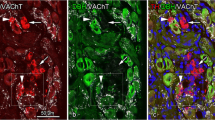Summary
Nerve fibers connecting the brain with the pineal gland of the Mongolian gerbil (central pinealopetal fibers) were investigated by means of light and electron microscopy.
Several myelinated fibers penetrate from the brain into the deep pineal gland, extend further into the pineal stalk and continue to the superficial portion of the pineal gland. In the centripetal direction these fibers were traced to the stria medullaris and to the habenular nuclei, where they turned laterad and then occupied a position immediately ventral to the optic tract.
As shown in electron micrographs, lesions of the habenular area led to degeneration of myelinated fibers and nerve boutons in the deep pineal gland, the pineal stalk and the superficial pineal gland. Only boutons containing clear transmitter vesicles (devoid of a dense core) were observed to degenerate after the habenular lesions. On the other hand, removal of the superior cervical ganglia resulted in degeneration of boutons containing small (40 to 60 nm in diameter) dense-core vesicles. Several of the nerve fibers that penetrate into the deep pineal directly from the brain (central fibers) exhibited a positive reaction for acetylcholinesterase (AChE). AChE-positive perikarya were located in the projections of the stria medullaris, the lateral portions of the deep pineal, the area of the posterior commissure, and the periventricular gray of the mesencephalon. Such perikarya were found neither in the pineal stalk nor in the superficial pineal gland.
These results present anatomical evidence that the pineal organ of the Mongolian gerbil receives multiple nervous inputs mediated by peripheral autonomic (i.e., sympathetic) nerve fibers, on the one hand, and by central fibers, on the other.
Similar content being viewed by others
References
Buijs RM (1978) Intra- and extrahypothalamic vasopressin and oxytocin pathways in the rat. Pathways to the limbic system, medulla oblongata and the spinal cord. Cell Tissue Res 192:423–435
Ham AW, Cormack DH (1979) Histology, 8th edition. J B Lippincott Comp. Philadelphia, Toronto, pp. 1–966
Kappers JA (1960) The development, topographical relations and innervation of the epiphysis cerebri in the albino rat. Z Zellforsch 52:163–215
Karnovsky MJ, Roots L (1964) A “direct-coloring” thiocholine method for cholinesterase. J Histochem Cytochem 12:219–221
Kenny GTC (1961) The “nervi conarii” of the monkey. An experimental study. J Neuropath Exp Neurol 20:563–570
Klüver H, Barrera E (1953) A method for the combined staining of cells and fibers in the nervous system. J Neuropath Exp Neurol 12:400–403
Koelle GB (1955) The histochemical identification of acetylcholinesterase in cholinergic, adrenergic and sensory neurons. J Pharmacol Exp Ther 114:167–184
Korf HW (1974) Acetylcholinesterase-positive neurons in the pineal and parapineal organs of the rainbow trout, Salmo gairdneri (with special reference to the pineal tract) Cell Tissue Res 155:475–489
Korf HW, Møller M (1983) Zentrale Innervation der Epiphysis cerebri bei verschiedenen Säugetieren. Verh Anat Ges 77 (in press)
Korf HW, Wagner U (1980) Evidence for a nervous connection between the brain and the pineal organ in the guinea pig. Cell Tissue Res 209:505–510
Loskota WJ, Lomax P, Verity MA (1974) A stereotaxic atlas of the Mongolian gerbil brain (Meriones unguiculatus). Ann Arbor Science Publ, Ann Arbor, Michigan, pp. 1–156
Møller M (1981) The ultrastructure of the deep pineal gland of the Mongolian gerbil and mouse: Granular vesicle localization and innervation. In: Matthews CD, Seamark RF (eds) Pineal function. Elsevier North-Holland, Amsterdam, pp. 257–266
Møller M, Korf HW (1983) The origin of central pinealopetal nerve fibers in the Mongolian gerbil as demonstrated by the retrograde transport of horseradish peroxidase. Cell Tissue Res 230:273–287
Møller M, Nielsen JT, van Veen T (1979) Effect of superior cervical ganglionectomy on monoamines in the epithalamic area of the Mongolian gerbil (Meriones unguiculatus): a fluorescence histochemical study. Cell Tissue Res 201:1–9
Møller M, Fahrenkrug J, Ottesen B (1981) The presence of vasoactive intestinal peptide (VIP) in nerve fibers connecting the brain and the pineal gland of the cat. Neuroscience Letters, Suppl. 7, 411
Moore RY (1978) Neural control of pineal function in mammals and birds. J Neural Transm Suppl 13:47–58
Nielsen JT, Møller M (1978) Innervation of the pineal gland in the Mongolian gerbil (Meriones unguiculatus). A fluorescence microscopical study. Cell Tissue Res 187:235–250
Nürnberger F, Korf HW (1981) Oxytocin- and vasopressin-immunoreactive nerve fibers in the pineal gland of the hedgehog, Erinaceus europaeus. Cell Tissue Res 220:87–97
Reiter RJ, Hedlund L (1976) Peripheral sympathetic innervation of the deep pineal of the golden hamster. Experientia (Basel) 32:1071–1072
Romijn HJ (1975) Structure and innervation of the pineal gland of the rabbit (Oryctolagus cuniculus) (L.), III. An electron microscopic investigation of the innervation. Cell Tissue Res 157:25–51
Rønnekleiv OK, Møller M (1979) Brain-pineal nervous connections in the rat: An ultrastructure study following habenular lesion. Exp Brain Res 37:551–562
Semm P (1981) Electrophysiological aspects of the mammalian pineal gland. In: Oksche A, Pévet P (eds) The pineal organ. Photobiology-Biochronometry-Endocrinology. Elsevier/North-Holland, Amsterdam, pp. 81–96
Uddman R, Alumets J, Lorén I, Sundler F (1980) Vasoactive intestinal peptide (VIP) occurs in nerves of the pineal gland. Experientia 36:1119–1120
Ueck M (1979) Innervation of the vertebrate pineal. Progr Brain Res 52:44–87
Vollrath L (1981) The Pineal Organ. In: Handbuch der mikroskopischen Anatomie des Menschen VI/7. Springer, Berlin, Heidelberg, New York, pp. 12–35
Wake K (1973) Acetylcholinesterase-containing nerve cells and their distribution in the pineal organ of the goldfish, Carassius auratus. Z Zellforsch 145:287–298
Zatz M, Kebabian JW, O'Dea RF (1978) Regulation of beta-adrenergic function in rat pineal gland. In: Birnbaumer L, O'Malley BW (eds) Receptors and hormone action. Vol. 3. Academic Press, New York, pp. 195–219
Author information
Authors and Affiliations
Additional information
This study was supported by grants from the Deutscher Akademischer Austauschdienst to M.M. (fellowship from July to September, 1981) and from the Deutsche Forschungsgemeinschaft to H.W.K. (Ko 758/1; 758/2-2)
Rights and permissions
About this article
Cite this article
Møller, M., Korf, H.W. Central innervation of the pineal organ of the Mongolian gerbil. Cell Tissue Res. 230, 259–272 (1983). https://doi.org/10.1007/BF00213804
Accepted:
Issue Date:
DOI: https://doi.org/10.1007/BF00213804



